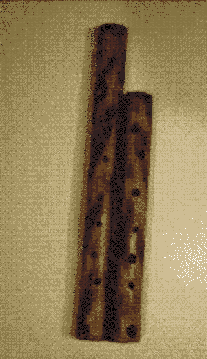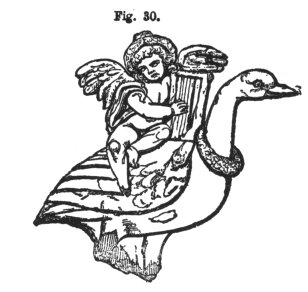Far and wide, in the realms of Paganism, was this
birth-day observed. This festival has been commonly believed to have had
only an astronomical
character, referring simply to the
completion of the sun's yearly course, and the commencement of a new cycle. But
there is indubitably evidence that the festival in question had a
much higher reference than this--that it commemorated not merely the
figurative birth-day of the sun in the renewal of its course, but the
birth-day of the grand Deliverer.
Among the Sabeans of Arabia, who regarded the
moon, and
not the sun, as the visible symbol of the favourite object of their
idolatry, the same period was observed as the birth festival. Thus we
read in Stanley's Sabean Philosophy: "On the 24th of the tenth
month," that is December, according to our reckoning, "the Arabians
celebrated the BIRTHDAY OF THE LORD--that is the Moon."
The Lord
Moon was the great object of Arabian
worship, and that Lord Moon, according to them, was born on the 24th
of December, which clearly shows that the birth which they celebrated
had no necessary connection with the course of the sun. It is worthy
of special note, too, that if Christmas-day among the ancient Saxons
of this island, was observed to celebrate the birth of any Lord of
the host of heaven, the case must have been precisely the same here
as it was in Arabia.
The Saxons, as is well known, regarded the
Sun as a female divinity, and the Moon as a male. *
* SHARON TURNER. Turner cites an
Arabic poem which proves that a female sun and a masculine moon were
recognised in Arabia as well as by the Anglo-Saxons.
It must have been the birth-day of the
Lord Moon,
therefore, and not of the Sun, that was celebrated by them on the
25th of December, even as the birth-day of the same Lord Moon was observed by
the Arabians on the 24th of December. The name of the Lord Moon in
the East seems to have been Meni, for this appears the
most natural interpretation of the Divine statement in Isaiah lxv.
11,
"But ye are they that
forsake my holy mountain, that prepare a temple for
Gad, and that furnish the
drink-offering unto Meni."
And Sharon shall be a fold of
flocks, and the valley of Achor a place for the herds to lie down in,
for my people that have
sought me. Isa 65:10
But ye are they that
forsake the Lord, that forget my holy mountain, that prepare
a table for that troop, and that furnish
the drink offering unto that number.
Isa 65:11
Gad
(h1409) gawd; from 1464 (in the sense of distributing); fortune:-
troop.
Gad (h1408) gad; a var. of 1409; Fortune, a
Bab. deity:- that troop.
Guwd (h1464) goode; a prim. root [akin to
1413]; to crowd upon, i. e. attack:- invade, overcome.
"But you who forsake the Lord,
Who forget My holy
mountain, Who set a
table for Fortune
(gad), And who fill cups with mixed wine for Destiny, Isaiah 65:11NAS
But because the rest of you
have forsaken the Lord and his Temple and worship gods of
"Fate" and "Destiny," Isaiah 65:11LIV
There is reason to believe that Gad refers to the
sun-god,
and that Meni in like manner designates the moon-divinity. *
*See KITTO, vol. iv. p. 66, end of
Note. The name Gad evidently refers, in the first instance, to the
war-god,
for it signifies to assault; but it also
signifies "the assembler"; and under both ideas
it is applicable to Nimrod, whose general
character was that of the sun-god, for he was the
first grand warrior; and, under the name Phoroneus,
he was celebrated for having
first gathered mankind
into social communities.
Then the angel of the LORD
ordered Gad to tell David to go up and build an altar to the LORD on
the threshing floor of Araunah the Jebusite. 1Chr.21:18
David, together with the
commanders of the
army, set apart some of
the sons of Asaph,
Heman and Jeduthun for the ministry of prophesying, accompanied by
harps, lyres and cymbals. Here is the list of the men who performed
this service: 1 Chronicles 25:1
Acaph
(h623) aw-sawf'; from 622; collector; Asaph, the name of three Isr., and of the family of
the first: - Asaph.
Asaph (h622) aw-saf'; a prim. root; to gather
for any purpose; hence to receive, take away, i. e. remove (destroy,
leave behind, put up, restore, etc.): - assemble, bring, consume,
destroy, fetch, gather (in, together, up again), * generally, get
(him), lose, put all together, receive, recover [another from
leprosy], (be) rereward, * surely, take (away, into, up), * utterly,
withdraw.
Meniy (h4507) men-ee'; from 4487; the
Apportioner, i. e. Fate (as an idol): - number.
The name Meni, "the numberer," on the
other hand, seems just a synonym for the name of Cush or Chus, which, while
it signifies "to cover" or "hide," signifies also "to count or
number." The true proper meaning of the name Cush is, I have no
doubt, "The numberer" or "Arithmetician"; for while Nimrod his son,
as the "mighty" one, was the grand
propagator of the Babylonian system of idolatry, by force and
power,
he, as Hermes, was the
real concocter of that system, for he is
said to have "taught men the proper mode of
approaching the Deity with prayers and
sacrifice" (WILKINSON); See
Homer's Hermes and the Music and lying connection.
and seeing idolatry and
astronomy
were intimately combined, to enable him to do so with effect, it was
indispensable that he should be pre-eminently skilled in the science
of numbers. Now, Hermes (that is Cush) is said to have "first discovered
numbers, and the art of reckoning, geometry, and astronomy, the games
of chess and hazard" (Ibid.); and it is in all probability from
reference to the meaning of the name of Cush, that some called
"NUMBER the father of gods and men" (Ibid.).
[Numbers and the
letters of the alphabet were magical
and became the first songs. Simply by singing the alphabet they could
call you into the presence of the gods]
The name Meni is just the Chaldee form of the Hebrew
"Mene,"
the "numberer" for in Chaldee i often takes the place of the final
e. As we
have seen reason to conclude with Gesenius,
that Nebo, the great prophetic god of Babylon, was just the same god as Hermes,
this shows the peculiar emphasis of the first
words in the Divine sentence that sealed the doom of Belshazzar, as
representing the primeval god--"MENE,
MENE, Tekel, Upharsin," which is as
much as covertly to say,
"The numberer is numbered."
[You will remember that David
numbered
Israel without
authority and brought a plague upon the people. He was too fearful to
go to the tabernacle to inquire of God and was permitted, because of
his faithlessness to build an alternate altar in Jerusalem]
The name Zer-Nebo-Gus is almost pure Chaldee, and seems to unfold itself as denoting "The seed of
the prophet Cush." We have seen reason already to conclude that,
under the name Bel, as distinguished from Baal, Cush was the great
soothsayer or false prophet worshipped at Babylon. But independent
inquirers have been led to the conclusion that Bel and Nebo were just
two different titles for the same god, and that a prophetic god. Thus
does Kitto comment on the words of
Isaiah 46:1 "Bel
boweth down, Nebo
stoopeth," with reference to the latter name: "The word seems to come
from Nibba, to deliver
an oracle, or to
prophesy; and hence would mean an 'oracle,' and
may thus, as Calmet suggests ('Commentaire Literal'), be no more than
another name for Bel himself, or a characterising epithet applied to
him; it being not unusual to repeat the same thing, in the same
verse, in equivalent terms." "Zer-Nebo-Gus," the great "seed of the
prophet Cush," was, of course, Nimrod;
for Cush was Nimrod's father.
There was another way in which
Nimrod's power
was symbolised besides by the "horn."
A synonym for Gheber, "The mighty one," was "Abir," while "Aber" also
signified a "wing."
Nimrod, as
Head and
Captain of those men of
war, by whom he surrounded himself, and who were the instruments of
establishing his power,
was "Baal-aberin," "Lord of the mighty ones." But "Baal-abirin"
(pronounced nearly in the same way) signified "The winged one," * and
therefore in symbol he was represented, not only as a horned bull, but as at once a horned
and winged
bull--as showing not
merely that he was mighty himself,
but that he had
mighty ones under his command, who were ever ready to carry his will into
effect,
and to put down all opposition
to his power; and to shadow forth the vast extent of his might, he
was represented with great and wide-expanding wings.
Hislop notes that the power of Nimrod's "horn" was music:
Looking at the subject in the
light of the Bacchanalian orgies, which, as the reader has seen, commemorated the
history of Nimrod,
it is evident that
he led mankind to seek their chief good in
sensual
enjoyment,
and showed them
how they might enjoy the pleasures of sin, without any fear of the
wrath of a holy God.
In his various expeditions he
was always accompanied by troops of women; and by music and song, and games
and revelries, and everything that could please the natural heart,
he commended
himself to the good
graces of mankind.
As the cup was peculiarly the
symbol of Cush, hence the pouring out of the drink-offering to him as
the god of the cup; and as he was the great Diviner, hence the
divinations as to the future year, which Jerome connects with the
divinity referred to by Isaiah. Now Hermes, in Egypt as the
"numberer," was identified with the moon that numbers the months.
He was called "Lord of the moon"
(BUNSEN); and as the "dispenser of time" (WILKINSON), he held a
"palm branch, emblematic of a year" (Ibid.).
Thus, then, if Gad was the
"sun-divinity," Meni was very naturally regarded as "The
Lord
Moon."
Meni, or Manai, signifies "The Numberer." And
it is by the changes of the moon that the months are numbered: Psalm
civ. 19, "He appointed the moon for seasons: the sun knoweth the time
of its going down." The name of the "Man of the Moon," or the god who
presided over that luminary among the Saxons, was Mane, as given in the
"Edda," and Mani, in the "Voluspa."
That it was the birth of the
"Lord Moon" that was celebrated among our ancestors at Christmas,
we have remarkable evidence in the
name that is still given in the lowlands of Scotland to the feast on
the last day of the year, which seems to be a remnant of the old
birth festival for the cakes then made are called Nur-Cakes, or
Birth-cakes.
That name is Hogmanay. Now,
"Hog-Manai" in Chaldee signifies "The feast of the Numberer"; in other words,
the festival of Deus
Lunus, or of the Man of the Moon. To
show the connection between country and country, and the inveterate
endurance of old customs, it is worthy of remark, that Jerome,
commenting on the very words of Isaiah already quoted,
about spreading "a table for Gad," and
"pouring out a drink-offering to
Meni," observes that it "was the custom
so late as his time [in the fourth century],
in all cities especially in Egypt and at
Alexandria, to set
tables, and furnish them with
various luxurious articles of
food, and with goblets containing a
mixture of new wine,
on the last day of
the month and the year, and that the
people drew omens from them in respect of the fruitfulness of the
year."
The Egyptian year began at a different time
from ours; but this is a near as possible (only substituting whisky for
wine), the
way in which Hogmanay is still observed on the last day of the last
month of our year in Scotland. I do not know that any omens are drawn
from anything that takes place at that time, but everybody in the
south of Scotland is personally cognisant of the fact, that, on
Hogmanay, or the evening before New Year's day, among those who
observe old customs, a table is spread, and that while
buns and
other dainties are provided by those who can afford them, oat cakes
and cheese are brought forth among those who never see oat cakes but
on this occasion, and that strong
drink forms an essential article of the
provision.
Even where the sun
was the favourite object of worship, as
in Babylon
itself and elsewhere, at this festival he was worshipped not merely
as the orb of day, but as God
incarnate. It was an essential
principle of the Babylonian system, that the Sun or Baal was the one only God.
When, therefore, Tammuz was worshipped as God
incarnate, that implied also that he
was an incarnation of the Sun.
Then he brought me
to the door of the gate of the Lords house which was toward the
north; and, behold, there sat women weeping
for Tammuz. Ezekiel 8:14
Then said he unto
me, Hast thou seen this, O son of man? turn thee yet again, and thou
shalt see greater
abominations than
these. Ezekiel 8:15
And he brought me
into the inner court of the Lords house, and, behold, at the door of
the temple of the Lord, between the porch and the altar, were about
five and twenty men, with their backs toward the temple of the Lord, and their faces toward the
east; and they worshipped the sun toward the east. Ezekiel 8:16
The cult of Tammuz centred around two yearly festivals, one celebrating
his marriage to the goddess Inanna. Inanna is Ishtar or Easter.
Then he said unto me, Hast thou
seen this, O son of man? Is it a light thing to the house of Judah
that they commit the abominations which they commit here? for they
have filled the land with violence, and have returned to provoke me
to anger:
and, lo, they
put the branch to their
nose. Ezekiel
8:17
Melody in Hebrew is related
to "pruning your vine" to "take your inheritance:
Zemowrah (h2156) zem-o-raw'; or z˙morah
zem-o-raw' (fem.); and z˙mor zem-ore' (masc.): from 2167; a
twig (as
pruned): - vine,
branch, slip
Zamiyr (h2158) zaw-meer'; or zamir zaw-meer';
and (fem.) z˙mirah zem-ee-raw'; from 2167; a song to be accompanied with instrumental
music: - psalm (-ist),
singing, song
Zamar (h2167) zaw-mar'; a prim. root [perh.
ident. with 2167 through the idea of striking with the fingers];
prop. to touch the strings or parts of a musical
instrument, i. e. play
upon it; to make music, accompanied by the voice; hence to celebrate
in song and music: - give praise, sing forth praises, psalms.
Here is a typical picture of
the branch
or "nose flute"--

The silingut is a nose flute used by the indigenous peoples of Sarawak. It is
used to play music for individual entertainment, but the use of the
nose breath attaches a special "magical" and religious significance to it. It used to be played during
funeral ceremonies to converse with the dead. In some regions it was also used
between lovers, as it's soft beautiful tone carried surprisingly well
through the night air.

One song begins:
"The wild bull who
has lain down, lives no more
the wild bull who has lain down, lives no more,
Dumuzi, the wild bull, who has lain down, lives
no more,
the chief shepherd,
lives no more
the wild bull who has lain down, lives no more....
his reed
pipe - the
wind will have to play
it,
"On his couch
in my husband's fold you have made the raven dwell,
my husband's songs - the north wind will have to sing them" -
"The Most Bitter Cry" you have made the jackals lie down,







